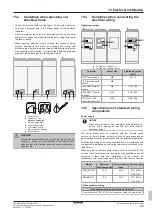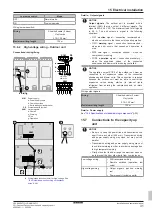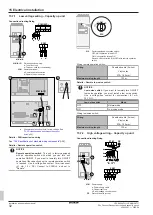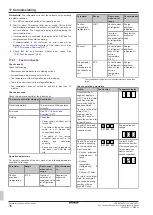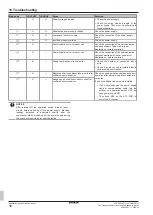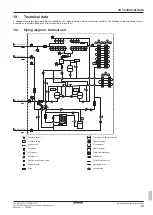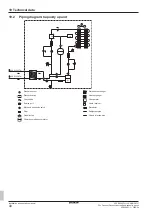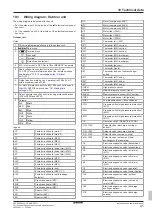
15 Electrical installation
Installation and operation manual
26
LRYELRNUN5A7Y1
CO
₂
Conveni-Pack outdoor unit and capacity up unit
4P605461-1 – 2020.04
3
Calculate the amount of refrigerant for the indoor units using the
Conversion ratio for indoor units: refrigeration
table in this
chapter, based on the type of indoor units and the cooling
capacity.
▪ Calculate the amount of refrigerant for blower coils:
(d)
▪ Calculate the amount of refrigerant for showcases:
(e)
4
Calculate the amount of refrigerant for air conditioner indoor
units using the
Conversion ratio for indoor units: air
conditioners
table in this chapter, based on the model of
indoor units and the number of units connected:
(f)
.
5
Total the amounts of refrigerant for indoor units:
(d)+(e)+(f)=[3]
.
6
Total the calculated amounts of refrigerant and add the required
amount of refrigerant for outdoor unit:
[1]+[2]+[3]+[4]=[5]
.
7
Charge the total amount of refrigerant
[5]
.
8
If a test runs indicates that additional refrigerant is needed,
charge the additional refrigerant and note down its amount:
[7]
.
9
Total the calculated amount of refrigerant
[5]
, the additional
amount of refrigerant during test run
[6]
, and the factory
charged amount of refrigerant
[7]
(see label on the unit). The
total amount of refrigerant in the system is thus:
[5]+[6]+[7]=[8]
.
10
Note down the calculation results in the calculation table.
Calculation table: outdoor unit with capacity up unit
Amount of refrigerant for liquid piping (refrigeration)
Liquid
piping size
Conversion
ratio per
meter of
liquid
piping (kg/
m)
Piping
length (m)
Total
amount of
refrigerant
(kg)
Ø9.5
0.0582
(a1)
Ø12.7
0.1030
(b1)
Ø15.9
0.1603
(c1)
Subtotal (a1)+(b1)+(c1):
[1]
Amount of refrigerant for liquid piping (air conditioner)
Liquid
piping size
Conversion
ratio per
meter of
liquid
piping (kg/
m)
Piping
length (m)
Total
amount of
refrigerant
(kg)
Ø9.5
0.0487
(a2)
Ø12.7
0.0858
(b2)
Ø15.9
0.1333
(c2)
Subtotal (a2)+(b2)+(c2):
[2]
Amount of refrigerant for indoor units
Type of indoor unit
Total
amount of
refrigerant
(kg)
Blower coils
(d)
Showcases
(e)
Air conditioner units
(f)
Subtotal (d)+(e)+(f):
[3]
Required amount of refrigerant for outdoor unit
(kg)
17.0
[4]
Subtotal [1]+[2]+[3]+[4] (kg)
[5]
Factory charged amount of refrigerant into
outdoor unit (kg)
6.3
[6]
Additional amount of refrigerant charged when
test run if required (kg)
(a)
[7]
Total amount of refrigerant [5]+[6]+[7] (kg)
[8]
(a)
The maximum amount of additional refrigerant that can be
charged at the time of the test run is 10% of the amount of
refrigerant as calculated from the capacity of connected indoor
units. Use [7]≤[3]×0.1 to calculate this maximum amount.
Conversion ratio for indoor units: refrigeration
Applicable for outdoor unit with capacity up unit.
Type
Conversion ratio
Blower coil
0.091 kg/kW
Showcase
0.454 kg/kW
Conversion ratio for indoor units: air conditioners
Model
Conversion ratio
FXSN50
0.14 kg/unit
FXSN71
0.22 kg/unit
FXSN112
0.34 kg/unit
14.4
To charge refrigerant
When charging refrigerant into the unit, take the following into
account:
1
Turn ON the power supply of the outdoor unit and all indoor
units (air conditioners, blower coils, showcases).
2
Turn OFF the operation switch of the outdoor unit.
3
Charge refrigerant from the charge port of the stop valve on the
refrigeration liquid side. Keep the stop valve closed.
4
When charging is finished, attach the valve caps to the stop
valve and service port.
Pressure difference too low
If the pressure difference between the charging cylinder and
refrigerant piping is too low, you cannot charge anymore. Continue
as follows to decrease the pressure in the piping and to be able to
continue charging:
1
Open both air conditioner and refrigeration gas stop valves and
air conditioner liquid stop valve.
2
Adjust the opening of the refrigeration liquid stop valve. In case
of long field piping length, the outdoor unit will automatically
stop when charging refrigerant with the liquid stop valve fully
closed.
3
Turn ON the operation switch of the outdoor unit. The pressure
in the refrigerant piping will drop, and charging can be
continued.
4
When the refrigerant is charged, turn OFF the operation switch.
5
Fully open all gas and liquid stop valves.
INFORMATION
After charging, add the total amount of refrigerant to the
name plate on the front panel of the unit.
15
Electrical installation
DANGER: RISK OF ELECTROCUTION
WARNING
ALWAYS use multicore cable for power supply cables.
NOTICE
The distance between the high voltage and low voltage
cables should be at least 50 mm.
Summary of Contents for LRYEN10A7Y1
Page 43: ......


















